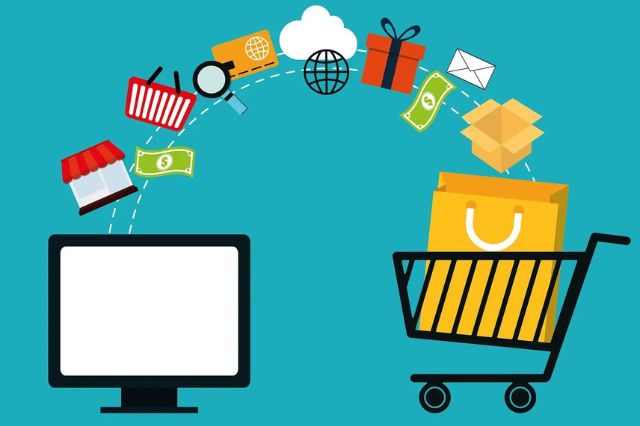Business
Global Ecommerce Expansion: Strategies for Breaking Into International Markets

Are you ready to take your ecommerce business to the next level? Breaking into international markets can be a game-changer for your brand.
In this article, we’ll explore key strategies and considerations for expanding globally. You’ll learn how to navigate cultural differences, localize your website, and build trust with international customers.
Plus, we’ll discuss the power of international marketplaces and cross-border platforms. Get ready to unlock new opportunities and watch your business thrive on a global scale.
Key Considerations for International Market Expansion
When expanding into international markets, you’ll need to consider a few key factors. One of the most important considerations is understanding the cultural differences in each market. Different countries have different customs, languages, and consumer behaviors. It’s crucial to conduct thorough market research to understand these cultural nuances and tailor your marketing strategies accordingly.
Another factor to consider is the legal and regulatory environment of the target market. Each country has its own set of laws and regulations regarding business operations, intellectual property, taxes, and data privacy. It’s essential to familiarize yourself with these regulations and ensure compliance to avoid any legal issues or penalties.
Additionally, you should assess the competition in the international market. Study your competitors’ strategies, pricing, and customer base to identify opportunities and challenges. By understanding the competitive landscape, you can develop a unique value proposition and differentiate your brand in the market.


Logistics and supply chain management is another critical factor. You’ll need to establish efficient shipping and delivery processes to ensure timely and cost-effective delivery to international customers. Consider partnering with local logistics providers to navigate any logistical challenges and optimize your operations.
Lastly, you must think about the financial implications of expanding into international markets. Consider currency exchange rates, payment methods preferred by customers in the target market, and potential tax implications. Develop a comprehensive financial plan to ensure profitability and mitigate any financial risks.
Understanding Cultural Differences in Global Ecommerce
To successfully navigate cultural differences in global ecommerce, it’s crucial to recognize that each country has its own unique set of cultural norms and values. By taking the time to familiarize yourself with these customs, you can better adapt your marketing strategies and tailor your offerings to meet the specific needs and preferences of your international customers.
For example, in some countries, it may be customary to negotiate prices, while in others, fixed pricing is the norm. Understanding these cultural nuances can help you establish trust and credibility with your customers, ultimately leading to increased sales and customer loyalty.
Additionally, it’s important to consider the holidays and festivals celebrated in your target markets. Tailoring your marketing campaigns and promotions to align with these events can be highly effective in capturing the attention and interest of your international audience. For instance, offering special discounts or creating themed product bundles during popular festivals can help you attract more customers and drive sales.
Localizing Your Ecommerce Website for International Customers
Localizing your ecommerce website for international customers can greatly improve user experience and drive higher conversion rates. Here are four key strategies to help you effectively localize your website:
- Language Localization: Translate your website content into the native language of your target market. This will make your website more accessible and relatable to international customers, increasing their trust and engagement.
- Currency Conversion: Display prices in the local currency to eliminate confusion and make it easier for customers to understand the value of your products. This will create a seamless shopping experience and reduce friction during the checkout process.
- Shipping and Payment Options: Offer localized shipping methods and payment options that are popular and trusted in the target market. This will make customers feel more comfortable and confident in making a purchase, leading to higher conversion rates.
- Cultural Adaptation: Understand and adapt to the cultural nuances and preferences of your target market. This includes using culturally appropriate images, colors, and symbols, as well as adjusting your marketing messages to resonate with the local audience.
Building Trust and Credibility in International Markets
Building trust and credibility in international markets is crucial for the success of your ecommerce website. When customers from different countries visit your site, they need to feel confident in making a purchase.
So, how can you build trust and credibility?
Firstly, ensure that your website is professional and visually appealing. A well-designed and easy-to-navigate site will go a long way in instilling trust in your potential customers.
Secondly, provide clear and accurate product descriptions, pricing, and shipping information. Transparency is key, as it helps customers make informed decisions.
Additionally, consider offering multiple payment options to cater to the preferences of customers from different regions. This not only enhances convenience but also shows that you value their needs.


Moreover, displaying customer reviews and testimonials can greatly boost credibility. Positive feedback from satisfied customers can help alleviate any doubts potential customers may have.
Lastly, prioritize customer support and responsiveness. Promptly addressing queries and concerns will demonstrate your commitment to customer satisfaction.
Leveraging International Marketplaces and Cross-Border Platforms
When selling on international marketplaces and cross-border platforms, it’s important to research and understand the specific regulations and requirements of each marketplace to ensure compliance and optimize your sales. Here are four key considerations to keep in mind:
- Localization: Tailor your product listings and marketing materials to suit the local language and culture of your target market. This will help you connect with potential customers and build trust.
- Shipping and logistics: Determine the most efficient and cost-effective shipping methods for your products. Consider factors like customs regulations, delivery times, and tracking options to provide a seamless experience for your customers.
- Payment options: Offer a variety of payment methods that are popular in your target market. This will make it easier for customers to complete their purchases and increase your chances of making a sale.
- Customer support: Provide reliable and responsive customer support in the local language. This will help address any concerns or issues that customers may have, ensuring a positive shopping experience and building customer loyalty.
Use Google Marchent Intégration APPS
Yotpo’s Google Merchant integration is invaluable for global ecommerce expansion in several ways.
Firstly, it enables businesses to effortlessly showcase their products on Google Shopping, reaching a vast and diverse global audience. This exposure increases brand visibility and attracts potential customers from around the world.
Moreover, Yotpo’s integration provides tools for collecting and displaying authentic user-generated content, such as reviews and ratings, which build trust with international shoppers. Additionally, it facilitates the management of product data, ensuring that accurate and up-to-date information is displayed to potential buyers globally. Overall, Yotpo’s Google Merchant integration streamlines the process of expanding into new markets, driving international growth and success for ecommerce businesses.
Conclusion
So, now you have a clear understanding of the key considerations for expanding into international markets with your ecommerce business. By focusing on understanding cultural differences, localizing your website, building trust, and leveraging international marketplaces, you can successfully break into new markets and reach a global audience.
Remember to adapt your strategies to each specific market and stay open to learning and adapting as you go. With determination and the right approach, you can take your ecommerce business to new heights on a global scale.
Good luck!
Finance
4 Reasons You Should Care about Your Credit Score


If applying for a small business loan, your credit score can make or break your chances of securing one and getting a good interest rate.
Whether starting a business, looking to expand, or requiring funds for other purposes, you may one day need a business loan. Getting the best terms possible is a priority. That’s one reason to consider your creditor score and how it’ll factor into your search for a business loan.
Here are four reasons your credit score matters. You’ll also see how to get help with credit score disputes if you can’t resolve such conflicts independently.
1. Credit Score Determines If You Get a Business Loan
If getting a business loan is a make-or-break issue for your company, you should be mindful of your credit score. Remember that lenders aren’t in the business of offering loans to people who present a substantial risk.
So, if your credit score is less than optimal, lenders could balk at lending you a loan or offer less money to reduce their risk. It’s a good idea to consider your credit score to see if you can realistically qualify for a business loan with reasonable terms.
Otherwise, you may have to explore other options to secure money for business needs. There are alternative ways to get funds. But it might mean accepting a higher interest rate or onerous terms.
2. Credit Score Affects Your Interest Rate
Even if you qualify for a business loan, you may not get a good interest rate if your credit score isn’t good. Even a few percentage points more could translate into paying back thousands more to complete your payback obligations.
You’ll have to consider whether you can afford to shoulder a high premium in interest payments to get a business loan you might not qualify for otherwise.
If forced to pay higher interest for a business loan, the lender may have other stringent terms. You should carefully consider the particulars before signing on the dotted line.
3. Credit Score Can Impact How Much You Qualify for
As was mentioned above, your credit score can influence how much a lender is willing to lend. If your credit is not good enough to grant you the amount you want, a lender may offer a business loan for a fraction of that sum.
That can happen when a lender doesn’t feel comfortable enough lending you more than a specific amount. It’s about limiting the potential fallout if you’re unable to pay your loan.
When a lender looks at your finances, it’ll know how much you can afford to pay back. If it determines you’ll struggle to pay back the amount you request, it might simply offer a lower amount more in line with your cash flow.
4. Credit Score Can Throw a Wrench in Your Business Plans
You may struggle to grow your business if you desperately need a business loan but have poor credit. In fact, you may face financial problems that threaten the long-term viability of your company. So, your credit score can make or break your business. Don’t allow bad credit to throw a wrench into your plans. If possible, improve your credit score before applying for a loan.
While a bad credit score can cause problems for your business, there are times when your credit report may include inaccurate information. Whether the credit report hasn’t been updated or includes completely false information, you may struggle to get the information corrected.
If you can’t make progress on this front, you may need to speak to a lawyer. A legal professional experienced in helping clients involved in credit score disputes can be a godsend.
Business
How Has E-commerce Evolved?


E-commerce has a relatively short history in business. The earliest incarnations of e-commerce stretch back to the 1970s, when early technologies such as teleshopping and Electronic Data Interchange helped to create a primitive version of this form of commerce.
However, modern e-commerce started to take off in 1994 when the entrepreneur Jeff Bezos set up Amazon from his garage. Initially, Amazon was an online marketplace just for books. In the years that followed, the range of products available increased.
Today, millions of unique products can be bought on the site, which has led it to become known as “the everything store.” Today, there are estimated to be over 26 million e-commerce websites worldwide, with around 13 million based in the US.
The e-commerce sector has grown rapidly and is predicted to continue to enjoy year-on-year growth for the foreseeable future.
However, in its relatively short history, there have been several developments that have shaped how companies operate online. In addition, consumer behavior and shopping preferences have changed as people regularly buy products and services online.
In this article, there will be a discussion of how e-commerce has evolved. Some key examples will be used to support this.
Social media promotion is integral to the sector
In the early days of e-commerce, there was far less competition between businesses because there were far fewer e-commerce firms. The internet has grown at an exponential rate since the early 1990s, and consumers can now find virtually any product, service, or specialist e-commerce firm online.
Due to the massive growth in the e-commerce sector, online firms now need to have a comprehensive marketing plan to promote their site and their products. This is vital to allow companies to stand out in an increasingly crowded online marketplace.
A key marketing strategy for millions of e-commerce firms is leveraging social media promotion’s power. Popular social media sites such as TikTok have around 1 billion monthly users, which makes the site a prime avenue for online promotions.
There is a global community of visitors to the site, which encompasses a wide range of demographics and target markets. Today, most e-commerce sites will have a marketing budget specifically for social media promotions.
They will create short but memorable adverts (typically using video) and will ensure that a hyperlink is embedded in the advert that takes the viewer to the product page of their website.
This simple strategy transforms customer interest into a sale with the lowest number of steps required on the part of the consumer. In short, social media promotion is a vital activity for any e-commerce firm and helps them to stand out in an increasingly crowded online marketplace.
The changing attitudes to delivery
In the early years of e-commerce, consumers understood that delivery timescales may be relatively long. Many customers were starting to buy from international sellers or fledgling e-commerce firms in their own country. During the early stages of e-commerce, there were few advanced delivery networks for online firms.
During the 1990s typical delivery timescales were far longer than today. Most products would take at least five days to arrive and potentially could be in transit for weeks.
Whilst consumers tolerated these timescales in the early days of e-commerce, they now expect quicker delivery schedules. In addition, if the stated delivery period is not adhered to and there are delays, many customers will stop using the e-commerce site.
As consumer delivery expectations increase, e-commerce firms must ensure that they can work with dependable and efficient shipping and courier firms. Companies such as Shiply USA may be ideal for smaller e-commerce firms that do not have their own delivery networks.
Such firms can offer highly competitive prices for shipping a range of goods. In addition, they have built a reputation for delivering to pre-stated timescales, with minimal levels of damage to items in transit.
In short, all e-commerce firms need to forge strong working relationships with professional shipping firms who can deliver on time and with competitive fees.
The rise of chatbots in online customer service
Finally, modern online shoppers expect that any queries or questions that they may have will be answered swiftly with excellent customer service. Not receiving a timely response to their correspondence creates a negative perception of the company and may make them less likely to purchase from the site.
E-commerce firms have been quick to recognize the value of swift responses to customer queries and are increasingly using AI to facilitate this. Chatbots are now widely used in e-commerce. They are programmed to understand language and detect the key question raised, directing customers to specific web pages with information on the topic.
This can help customers get the information they need and reduce the reliance on a large human customer service team, keeping such staffing costs low.
Business
8 Tips for Better Product Consistency


When it comes to building a business that people trust and recognize, there’s no replacement for consistency. More specifically, you need the quality and output of your products to be consistent across the board.
However, with so many different moving parts involved, this is often easier said than done.
- Standardize Your Processes
Start by examining your current processes and how things are being handled at every step of the production process:
- Are they documented?
- Where are they documented?
- Is there a clear blueprint that everyone can follow?
Standardization is the backbone of consistency. It involves setting clear guidelines for every stage of your production, from the initial design to the final output. This means having detailed, step-by-step instructions that leave no room for ambiguity.
It’s a smart idea to implement checklists and workflows, which are easy for people to follow. This ensures every product goes through the same procedure, minimizing variations that can lead to inconsistencies.
- Implement Rigorous Quality Control
Quality control is non-negotiable. With that in mind, introduce systems that scrutinize your products at multiple stages of the production process. This might involve regular spot checks, pre-shipment inspections, and even post-market quality assessments.
The goal of quality control is to catch and address any deviations before they reach the customer. Consider adopting statistical quality control techniques like Six Sigma, which can help you measure, analyze, and reduce variability in your manufacturing process.
- Leverage Technology and Automation
Don’t ignore the resources you have available at your fingertips. This includes technology and access to outside partners.
In terms of tech, automation has the ability to reduce human error and ensure that each part of your product meets exact specifications. When it comes to outside partners, you can always hand off parts of your process to an experienced contract assembly company to make sure you get the same result every single time a product is packaged.
- Train and Engage Your Employees
Your employees are the real MVPs behind your product, and their skills and commitment play a pivotal role in consistency. Even if the majority of the production is happening with the help of automation, it ultimately comes down to the people who are implementing the systems, spot-checking the production processes, and keeping everything running.
The best thing you can do is invest in comprehensive training programs that teach your employees about the technical aspects of their jobs while instilling a deep understanding of the importance of consistency. Engaged employees who share a commitment to your brand’s standards are less likely to cut corners and more likely to maintain high quality in every task they perform.
- Gather and Utilize Feedback
Feedback is a powerful tool – don’t ever forget it. While not always comfortable – and quite often painful – gathering feedback forces you to come eye-to-eye with how you’re actually doing. (Not just how you think you’re doing.)
Gather input from your customers, employees, and even suppliers on a regular basis to find out where there might be inconsistencies in your product. This can provide invaluable insights into areas that may need adjustment. Use this feedback to fine-tune your processes and training, ensuring that your products continually meet customer expectations and industry standards.
- Monitor and Adapt Your Supply Chain
The consistency of your product is also highly dependent on the materials you use. Variability in materials can lead to variability in the final product. Keeping this in mind, build strong relationships with reliable suppliers whose products meet your quality standards.
Regular audits and supplier evaluations can also go a long way towards helping ensure that the materials you receive remain consistent in quality and function.
- Set Realistic and Clear Expectations
While striving for perfection, set realistic expectations for your team and your processes. This might seem like an oxymoron, but it’s all about your mentality. Perfection is always the goal, but you also have to remember that people are people – meaning they will make mistakes.
Don’t accept these mistakes, but also don’t ruin relationships when people don’t live up to the goal of perfection. Instead, go back to the drawing board and find ways to limit those mistakes in the future.
- Prioritize Continuous Improvement
The journey to product consistency is one that never ends. Markets evolve, technologies advance, and customer preferences change. Maintain a mindset of continuous improvement, regularly reviewing and refining your processes to adapt to new challenges and opportunities.
This proactive approach will keep you ahead of the curve, ensuring your products consistently meet the high standards your customers expect.
Invest in Consistency
If you make a commitment to product consistency, you’ll never regret it – not even for a day. It can be costly and time-consuming on the front end, but it’s one of the most financially rewarding investments you’ll ever make in the long run.
Start with the tips highlighted in this article and begin shifting your focus in a new direction!
-



 Captions3 years ago
Captions3 years ago341 Sexy Captions to Fire Up Your Instagram Pictures
-



 Captions3 years ago
Captions3 years ago311 Night Out Captions for Instagram and Your Crazy Night
-



 Captions3 years ago
Captions3 years ago245 Saree Captions for Instagram to Boost Your Selfies in Saree
-



 Captions3 years ago
Captions3 years ago256 Best Ethnic Wear Captions for Instagram on Traditional Dress
-



 Captions3 years ago
Captions3 years ago230 Blurred Picture Captions for Instagram
-



 Captions3 years ago
Captions3 years ago275 Deep Captions for Instagram to Express Your Thoughts
-



 Quotes3 years ago
Quotes3 years ago222 Nail Captions for Instagram to Showcase Your Fresh Manicure
-



 Captions3 years ago
Captions3 years ago211 Laughing Captions for Instagram | Laughter Is the Best Medicine







